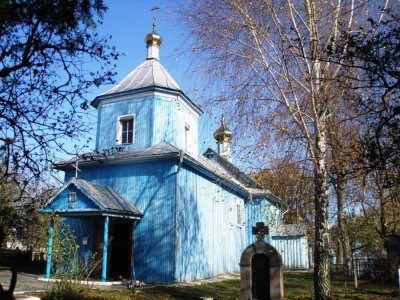The church was opened in 1980 during the celebration of the 1000th anniversary of the city. It was built in 1802 by Archpriest Anthony Loiko. This is reported by Malikov Ya.R. at the scientific and practical conference "Historical heritage of the city of Turov" held in 2015. In his article, he refers to the clerical statements, which were compiled for each church according to the litany, described both the material side of the life of the parish (the number of parishioners, profit per year, the condition of the temple) and the state of the priests (number, education, family composition), as well as non-parish churches and chapels assigned to temples. In the book "Description of churches and parishes of the Minsk diocese. Mozyr district", the following description is given: "The oldest church in p. Turov is currently considered a Cemetery, in the name of All Saints, it was built in 1802 by the care of Archpriest Loiko." According to the data of the mid-19th century, services in the church were held only on All Saints' Week. In 2012, the publishing house "The Belarusian Encyclopedia named after P. Brovka" published an album of photographs taken by the Belarusian ethnographer I.A. Serbov in 1911-1912 during a scientific expedition. Among these photographs there are a number of photographs taken in Turov in 1912, including two pictures of the church in the cemetery. Both photos show a small three-log church, in which all rectangular log cabins are exposed in one line: the narthex under the belfry is the main room – the apse. At the same time, all three log cabins are covered with separate roofs – a tower with a four-pitched roof is located above the narthex on the second floor, the main room of the temple is slightly larger than the rest of the log cabins and is covered with a high four-pitched roof, to which a three-pitched roof over the apse is attached much lower. Each of their roofs ends with a small turret with a cibuline and a six-pointed metal cross. Such a composition of the temple, in which each log house ended with its own separate roof, is generally inherent in the Belarusian architecture of the 17th and 18th centuries, including Polesskaya, which is confirmed by well–known analogues - the church of 1724 in Davyd-Gorodok Stolinsky district, the church of 1765 in v. Skorodnoye, Yelsky district. It is obvious that during the existence of the temple in the 20th century. It has been significantly rebuilt – its length has almost doubled: the entrance part has been significantly lengthened; the altar part became narrower (equal in width to the narthex), but also longer, a faceted apse was additionally attached to it; the original individual roofs over each ceiling were replaced with gable roofs over the entire temple. Recently, two icons of the 17th century have been updated in the Church of All Saints. Miraculously, an icon of the Guardian Angel was discovered, from which the door of the temple extension was made. Also, the icon with images of the Turov saints is especially revered: Saints Cyril, Lawrence (with a particle of relics) and St. Martin. In the Church of All Saints on the right side there is one of the ten stone crosses that sailed according to legend in the 10th century from Kiev to Turov on the river against the current.

